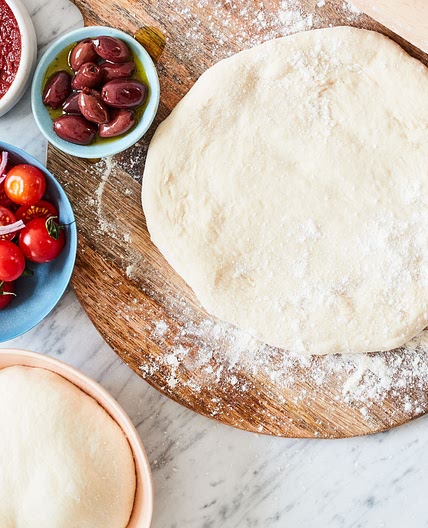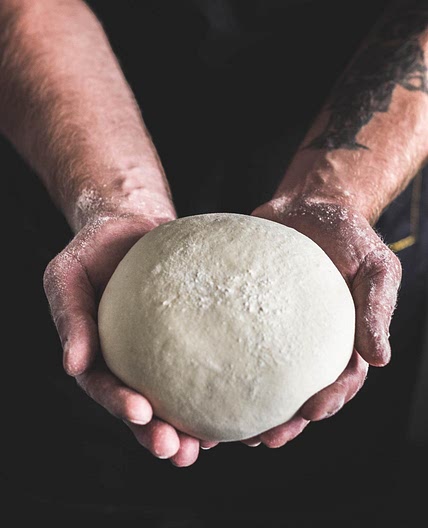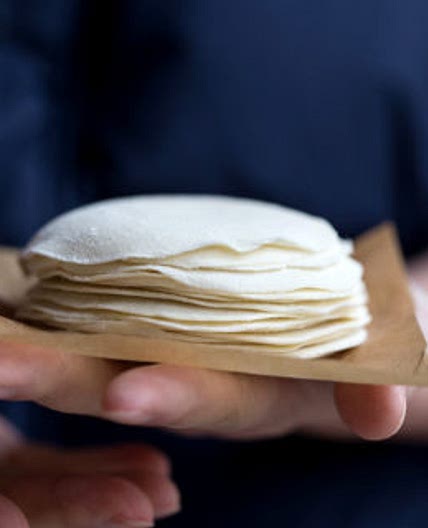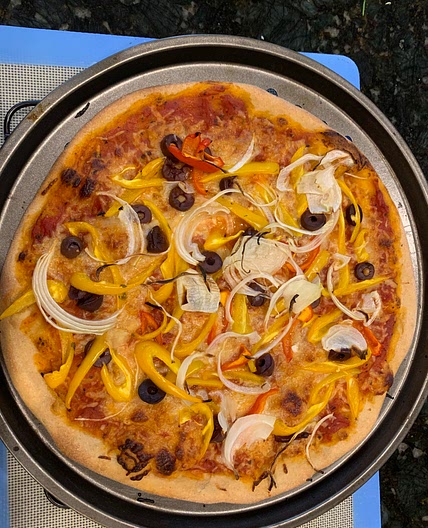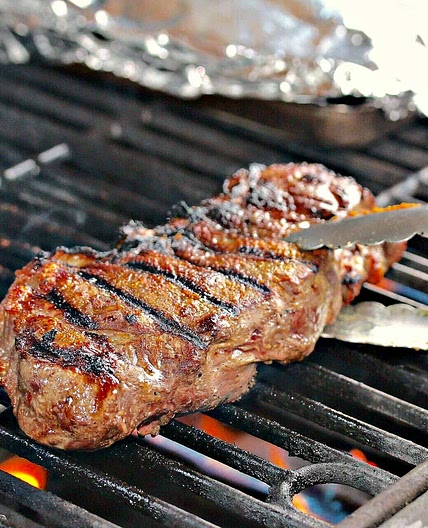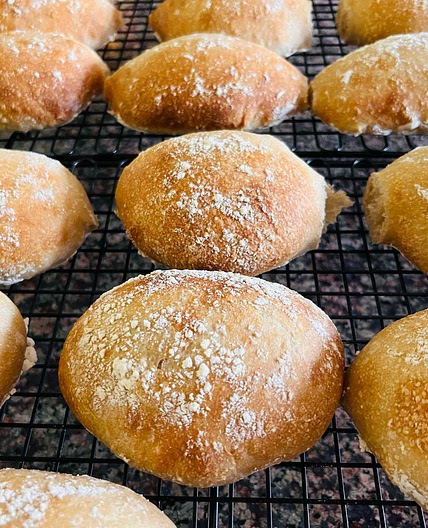
1/10

2/10

3/10

4/10

5/10

6/10

7/10

8/10

9/10

10/10
89%
16
By Lacey (Lace Bakes)
Sourdough Pizza Dough
16 steps
Prep:24hCook:8min
Sourdough pizza dough takes a bit of time, but you'll be rewarded with a crispy, chewy crust with tons of flavour!
I've linked the video tutorial for my pizza dough recipe using yeast - the process of working with the dough is exactly the same, there are just three key differences:
1) Instead of mixing the yeast/flour/water the evening before, you feed your sourdough starter: 20g starter, 100g bread flour, 100g cold water. It will be ready to use in the morning.
2) The sourdough recipe does not have any honey.
3) The sourdough recipe calls for 300g of water instead of 290g.
So do check out the video tutorial, just keep in mind those points I've made above.
Updated at: Thu, 17 Aug 2023 10:00:13 GMT
Nutrition balance score
Good
Glycemic Index
70
High
Glycemic Load
82
High
Nutrition per serving
Calories608.1 kcal (30%)
Total Fat4.2 g (6%)
Carbs116.9 g (45%)
Sugars1 g (1%)
Protein20.7 g (41%)
Sodium1084.3 mg (54%)
Fiber11.3 g (40%)
% Daily Values based on a 2,000 calorie diet
Ingredients
4 servings
Instructions
For the Sourdough Starter (mix the evening before you plan to make dough)
Step 1
To make the 200g of sourdough starter: discard all but 20g of sourdough starter. Feed the remaining 20g of starter with 100g bread flour and 100g of cold water. Mix well. Leave covered at room temperature overnight. You'll use 200g of this in your dough the next morning, and you should be left with an additional 20g starter.
Step 2
You can also feed the starter first thing in the morning on the day you plan to mix your dough. Instead of 20g of starter, use 40g of starter and feed it with 90g bread flour and 90g slightly warm water to encourage it to puff up quickly so you can make the dough later in the afternoon.
Pizza Dough
Step 3
In a large mixing bowl, combine all ingredients together and mix until smooth. I use my stand mixer for ease, but you can get messy and mix this together by squishing the dough together with your hand. It may feel a bit dry if you're mixing by hand, but don't add in extra water - it will all come together eventually. Once there are no dry patches left in the dough, squish/mix for about 30 seconds to 1 minute longer. The dough will feel quite stiff - it will soften/aerate over the duration of the proof time.
Step 4
Cover the bowl with a tea towel or lid and let the pizza dough rest at room temperature for about 45 minutes. At this point you’ll perform the first set of stretch and folds (see my tutorial on Instagram/TikTok for how to do a stretch and fold). You’ll do another two sets of these stretch and folds, each spaced about 45 minutes to 1 hour apart from one another.
Step 5
When the dough is finished, it will be stretchy, aerated and will have grown in volume by at least a third. This takes about 3-4 hours from the time the dough is was initially mixed.
Step 6
After it’s finished proofing, cover the bowl tightly and pop into the fridge overnight. I use a lidded bowl. You can also use plastic wrap, a plastic shower cap, a Tupperware container - anything that will protect the dough from drying out in the fridge overnight. The dough will continue to rise, ferment and develop flavour in the fridge overnight. Just be sure there is a little bit of room for the dough to grow in the bowl or lidded container.
Shaping and Proofing (24-48 hours after mixing dough)
Step 7
About 3-4 hours before you plan to make your pizzas, take your dough out of the fridge to divide and shape into balls as demonstrated in my tutorial. This recipe yields 4x 250g (9oz) pizza dough balls, but of course you can divide into the size that you’d like.
Step 8
Dust a tray liberally with plain flour and semolina, then coat the dough balls in the flour/semolina mix before placing them on the tray. Cover tray with a tea towel, plastic wrap or another tray and proof at room temperature for about 3-4 hours before using. The dough balls will puff up and become easy to stretch out for when it’s time to make your pizzas.
Cooking the pizza
Step 9
Preheat your broiler or grill (they mean the same thing, it’s just that the USA/UK call the direct heat source at the top of the oven by different names. I set my broiler/grill to 275C or 525F - so HOT!
Step 10
Stretch out pizza dough (see my tutorial for tips) and lay it into a lightly oiled preheated frying pan (28cm/11 inch or larger) on the stovetop. Cook over medium high heat, topping the dough with your choice of sauce, cheese and toppings.
Step 11
When the bottom of the crust is golden brown and crispy, remove the pizza from the frying pan and transfer to an oven rack placed in the upper 1/3 of your oven.
Step 12
The direct heat from the grill/broiler should cook the pizza in 2-4 minutes, watch closely so it doesn’t burn. The crust should be crispy and a light golden brown (potentially with some blackened spots on the bubbles) when it’s finished.
Step 13
If you don’t have a broiler, set your oven to its highest heat and transfer it in to the oven from the frying pan once the base is golden brown. It will take a little more time to bake if you’re not using the extreme direct heat from the broiler - 5/10 minutes - keep an eye on it!
Step 14
Of course, pizza ovens are brilliant too - I feel like the dough is even better when cooked at such extreme heat - it puffs up much more somehow. I love my Gozney Roccbox! But I do realise not everyone has a pizza oven, so I wanted to show you the best way to get restaurant quality pizzas using a home kitchen set up. I hope you enjoy!
NOTES
Step 15
Digital Scales: You’ll notice I always use a digital scale for my bread related recipes. Measuring flour with measuring cups can vary too much (how tightly the flour is packed, etc) which means the recipe might not be as reliable. Digital scales are inexpensive, easy to use and they help to save you from having to wash up too many measuring spoons/cups - you just measure ingredients right into the bowl. If you plan to start baking your own bread, pizza dough or focaccia, invest in a digital scale to ensure you're getting precise measurements.
Step 16
Freezing pizza dough: pizza dough can be frozen after the pizza dough ball shaping stage. Place each dough ball into individual freezer bags and then pop them into freezer. The day before you plan to use, them take them out of the freezer and place them, still in their freezer bag, into the fridge to thaw overnight. About 4 hours before using them, remove from bag, coat in flour and place on floured tray to proof (same as in main recipe). The dough is best when it’s used fresh but this is a great solution for those wishing to plan ahead or if you want pizza on a whim.
View on Click for pizza dough tutorial
↑Support creators by visiting their site 😊
Notes
76 liked
9 disliked
Delicious
Go-to
Easy
Crispy
Fresh









